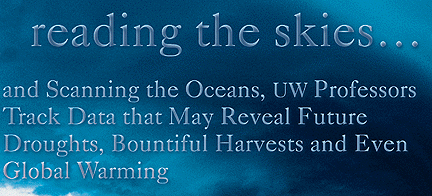 By David Brand
By David Brand
 By David Brand
By David Brand
A 40-year-old gutted aircraft stands in a hangar at Paine Field north of Seattle, its temporary plywood floor and protruding wiring seeming to indicate the junkyard rather than a bright future in scientific research.
But the Convair 580 turboprop, obtained by the University of Washington from U.S. government surplus, is undergoing a $1.5 million retrofit that will soon make it one of the world's finest atmospheric research aircraft. By early next year it will be an airborne "critical-care" unit, analyzing the atmosphere in many different ways, from temperature and humidity to structures of clouds and pollution. The mission of Peter Hobbs, the aircraft's guiding spirit: to understand how nature seems to be protecting the Earth from greenhouse gases, the fallout from humanity's industrial appetites.

Yet there is more than just global warming on his mind. Hobbs, a UW atmospheric sciences professor, hopes to find data in the skies that will pin down better predictions of what the climate will be in the future.
Hobbs is part of the new world of climate prediction, a world made possible by supercomputers and weather observations made on land, on the sea, in the sky and in space.
Since the early 1990s this emerging science has undergone such rapid growth that today 10 institutions worldwide are making relatively reliable climate predictions. Their monthly forecasts, made for one year ahead, are winning a host of disciples: coffee growers in Brazil concerned about the futures market, farmers in Australia who may have to switch to drought-resistant seeds, salmon fishers in the Northwest who track salmon runs, water managers who worry about reservoir levels, and state and federal disaster agency officials.
Few institutions have had as profound an impact on this science as the UW. Whether researching short-term predictions based on Pacific Ocean water temperatures or providing data for the century-long challenge of understanding global warming, UW scientists are in the forefront. We are, says Atmospheric Sciences Professor Edward Sarachik, in the early stages of discovering "where the memory of climate lies."
What is climate? Well, it isn't weather. Weather is something that happens in days, or at the most two weeks, and then is gone. Weather is tomorrow's high winds, next weekend's rain or next month's sunshine. Climate is summer and winter, it is months or even years during which global movements of hot and cold ocean waters and air masses go through cycles that can bring droughts or floods.
If weather forecasting is cause and effect on the shortest possible time scale, then climate prediction indicates the global conditions in the oceans and the atmosphere for years ahead. As researchers like to put it, "Climate is what you expect. Weather is what you get."
Climate prediction research at the UW is fast moving on three fronts:
* Short-term forecasting of one to four years ahead. These predictions are based on the episodic appearance of warm surface waters in the Pacific Ocean, called El Niño, which can cause climatic chain reactions around the world.
* Medium-term predictions involving changes in climate that can persist for decades. The big problem to be solved, says UW Atmospheric Sciences Professor Mike Wallace, is "to learn how to recognize these transitions when they're occurring, without the benefit of hindsight."
* Long-term prediction, looking ahead 50 to 100 years. This relies on a deeper understanding of global warming. Since the beginning of the century, there has been a 1 degree Fahrenheit rise in the average temperature of the Earth's surface. One difficulty facing scientists is sorting out how much of the temperature rise has been due to industrial pollution, and how much is due to natural climate variations.
Short-Term Climate Predictions: El Niño is the
Star Performer
Medium-Term Predictions: Ocean
Monitoring is the Key
Long-Term Predictions: The
Threat of Global Warming
Send a letter to the editor at columns@u.washington.edu.